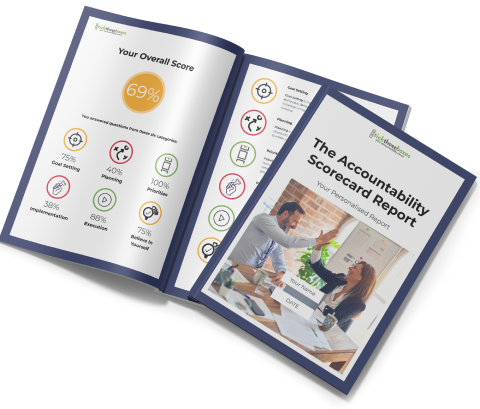Navigation
Learn More
Contact
- +61 418 379 369
- df@tickthoseboxes.com.au
-
P.O Box 282
Caulfield South. Vic 3162
Australia - Contact Form
Social Media

Posted on: 21/07/2022

Are you trying to foster accountability in your workplace? You might want to hold an accountability session in the workplace. Holding accountability sessions lets you communicate with your accountability group, partners, or coach. Additionally, it enables you to communicate accountability goals with your team.
Essentially, an accountability session takes place between decision-makers and employees. It allows both to hold the other responsible for their actions and results. They are sessions to let employees know their tasks and goals. It also involves decision-makers making commitments and taking positions.
You might wonder how to hold such a session, isn’t it? Fret not; this blog will give some tips on holding an accountability session. It will also provide you with some tips on fostering accountability in the workplace.

Discover your Accountability Score and increase the probability of smashing your GOALS and Getting Sh!t Done!
Holding accountability sessions between decision-makers and employees in the workplace is crucial. It gives a platform for employees to address grievances and decision makers to analyze results and provide feedback.
Here are some valuable tips on holding a successful accountability session:
The foremost step in holding the accountability session is to list the session’s goals. You can list goals like discussing project progress, employee performance, decision makers’ performance, and setting task deadlines.
Moreover, listing goals for the accountability session sets the agenda for the session. It allows you to formulate what all issues need to be addressed and solved.
Ensure you set the room nicely. The accountability room should be arranged in a friendly yet professional manner. You can have a hot seat arrangement if you need to hold a specific person accountable. Alternatively, you can choose a conference room arrangement to have a healthy discussion and have a back and forth between employees and decision-makers.
The room arrangement will set the tone of the session. It can either be a feedback discussion or a targeted approach depending on how you arrange the room.
While conducting accountability sessions, ensure you find a balance between having a disciplinary session and a feedback session. The motive of an accountability session is to empower employees and decision-makers to have a discussion and make changes to the organization.
So, it should not be about reprimands only. It should also be about decision-makers changing policies and rules to foster accountability.
The accountability session can be the perfect avenue to work as a team and get the best results. For instance, if you are working on a project, you can ask your employees about the progress and get decision makers to talk about the next steps and how to resolve issues that crop up.
That way, you increase the interaction between employees and decision makers and bridge the gap.
Another critical aspect of a good accountability session is to evaluate the session. Evaluation will enable you to understand whether you have achieved the goals of the session. It will give you a list of actions that must be performed before the next accountability session.
Now that you know how to conduct an accountability session successfully, here are some tips for promoting accountability in the workplace:
The best way to foster accountability is to set specific, measurable, attainable, relevant, and time-bound goals. Goals will give you something to work towards and build your aspirations. It will provide clarity.
Having accountability sessions with back-and-forth feedback between employees and decision makers is vital to fostering accountability. These sessions will allow you to understand where the company stands.
You will foster accountability when you avoid the blame game. Suppose something goes wrong in the project. Instead of finding someone to blame, hold yourself accountable and work towards solutions.
You must communicate your goals well with clarity, comprehension, and crispness. Moreover, ensure there is an open line of communication between employees and decision makers to bridge the gap.
Ensure your employees have the resources and skills to perform their tasks. Otherwise, they will find it difficult to assume responsibility and ensure accountability for their tasks. Hold workshops, accountability, coaching, and training periods to ensure your employees are well-equipped.
Accountability sessions are an effective way to know the progress of your company. It indicates how your employees and performing. It also tells employees where they stand. For having a good accountability session, ensure you arrange the room, list goals, find a balance, work as a team, and evaluate the session.
Moreover, having an accountability session will contribute to fostering accountability in the workplace. This means you can boost morale, improve productivity, and increase the business’s profitability.
Furthermore, you can increase accountability by setting goals, having accountability sessions, training employees, communicating well, and avoiding the blame game.
So, make your workplace healthy by having accountability sessions and fostering accountability. You can also take the help of agencies like TickThoseBoxes to hold your accountability sessions successfully.

Darren Finkelstein, The Accountability Guy®, is the founder of TICK THOSE BOXES, a specialised accountability coaching practice. Darren is a formidable international accountability coach, business advisor, mentor, and author/speaker, fostering development and measurable results in entrepreneurship, leadership, and accountability. Darren’s tale is one of perseverance, self-reinvention, and resilience.
With compelling execution, Darren has empowered high-achieving individuals and teams from Australia and New Zealand to Latin America, Europe, Asia, the UK, and the US to embrace accountability; after all, it is your superpower.
Darren’s one-on-one and group coaching programs are based on his bestselling business book, “The Accountability Advantage – Play your best game” and the latest, release “NO’ – Building a life of choice without obligation”.
Darren has an impressive background in business, having held the role of “Manager of Commercial Markets” at Apple Australia during the Steve Jobs revolution.
He enthusiastically “walks the talk,” having also successfully sold and exited his lifestyle businesses, which served as the impetus for establishing his coaching and mentoring business.
Join Darren on this transformative quest to accomplish the remarkable.
Read Darren’s full bio here:
https://tickthoseboxes.com.au/about/

Know what to do first

know what to do next

know what to do more of
Navigation
Learn More
Contact
Social Media
© 2025 TickThoseBoxes® | Privacy Policy | Terms and Conditions
I was excited to join Tia Harmer on The Work in Progress: The Personal Productivity Science Insights Podcast! We dive deep into the science of goal setting and the power of accountability—two cornerstones of business and personal success.